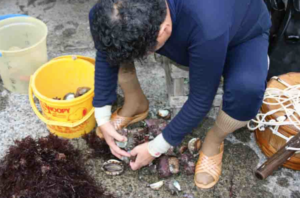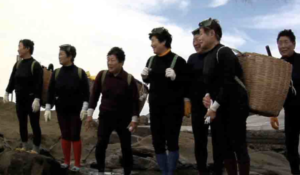Documentary Short, 13 minutes, color
Produced for Tsuda Women’s College, Japan, Producer: Yuko Takehashi
Director: Amie Williams
Diving together for decades, the Amasan of Shirahama have formed a tightly-knit bond, as well as a business co-operative, providing economic security for their husbands and families. Hardly the timid, self-effacing stereotype of the Japanese female, these women embody a courage and spirit rarely portrayed in films about women in Japan. The film champions the brazen spirit of these seven Ama, and brings their inspirational stories to an international audience. At a time when the pressures of globalization and environmental degradation have wreaked havoc on the fishing industry worldwide, these women and their inherently balanced, almost sacred relationship with the sea serves as a metaphor for a way of life fast disappearing. It’s a film that celebrates growing old while embracing the beauty, camaraderie and longevity of female friendship, defined by lives lived mostly “underwater” and the freedom that they find beneath the sea.


The film unravels much like a meditation, or Japanese Zen “koan” where each chapter poses a different answer to the question of why these women continue to dive under such harsh and challenging conditions. Ultimately, the answer lies in the spaces between any set conclusion.
“I don’t know what I would do if I could not come to the sea every day and dive…the secret to carrying on in life is only this.”
Without narration or overt editorializing, the film follows the rhythms, color and detail of every-day life for seven Amasan in Shirahama. The cinematography itself reflects the ritualistic, mindful movements of the Ama, with long, sweeping takes of their environment, and small, studied aspects of their craft. The seaside village of Shirahama looks much the same it did decades ago, with almost a “film-set” like quality wherever one points a camera. Yet the Ama are not stuck in a time warp, as they drive their farm trucks full-speed on narrow, winding roads or chat animatedly into a cell phone.
Shot on HD, both underwater and on land, the filmmakers achieve a rich film-look palette, to mirror the balanced, natural aesthetic inherent in the Ama’s profession. Less a national geographic reportage, the film will unfold in a non- linear fashion, allowing for the spontaneous unfolding of circumstances.
The seven Ama are:
Emiko Yoshido. age 72
Kasuko Hayakawa, age 68
Tomiko Miyamoto, age 65
Kiyoe Yoshida, age 58
Masae Hayakawa, age 69
Reiko Miyamoto, age 70
Etsuko Wada, age 60
Even as their own daughters leave to take “salaried jobs” in the city, these Ama proudly carry on, clearly in love with what they do. We learn that part of this love is born out of the hours they spend together, in the amagoya, or women’s cabin, a special place where they gather every morning to prepare their equipment, eat and dress for the dive. This space, because it is theirs alone, separate from the demands of husbands and outside society, becomes a symbol for female independence and self-expression.
Because diving requires great skill, these Ama have always held a special place in their society, autonomous and self-sufficient, as precursors to the “enlightened and modern” Japanese women of today. Yet they do not see their role as unique, it is in a sense, the way things always were, and they do not flaunt their independence. Quite the opposite, they rely on each other.
“Sea friends, friends who share the ocean are the best friends of all…”
What is most touching is the camaraderie these women have developed over sixty years of diving together. Two of them are sisters, many of them went to school together. One Ama has helped another bury a husband, another suffered a minor heart attack while diving, and had to be rescued. Still another gave birth on the shore, after going into labor while diving. Spending time with them, one is struck by their simple joy in the smaller things: a type of medicinal herb for arthritic pain, a story told over and over, a candy savored for hours before diving. It is the “wabi-sabi” or “suchness” of ordinary life that contrasts with the enormity of what they face every dive: dangerous, nauseating waves, hours spent searching for fewer and fewer shellfish, and a shrinking return for their efforts.
Everyone is thinking, more abalone, more abalone, but if you do not conserve your breath, it is easy to choke and die. I have seen it happen. Maybe this is why we do not worry about the small things in life. Our life every day is in danger.
As the film unfolds we get a keen sense that the Ama’s life has dramatically changed over time. In 1965, one Ama tells us, she could earn 10 million yen (about 85,000 dollars) for a season’s work. “As I was a good Ama, I was also sought after by many young men.” At that time there were over 1,500 active Ama in the region, compared to less than 300 now. Although the women are guarded about how much money they actually earn diving now, it is clear it is far less. Powerful economic and social forces are pressuring Ama to leave the profession, and it is also being replaced by a tourist-friendly, fantasy-Ama image.
“When a woman puts her hands into the ocean, we do it not to disturb, but to restore the balance…a balance that has been lost and forgotten.”
Diving for abalone is hard work, and while they spend at most an hour or two in the water each day, it takes them twice that to recover, back at the amagoya, in front of a fire, where they bring their bodies back from minor hypothermia. A central part of the film will be captured with underwater cinematography, to give a detailed, up-close accounting of what they actually do to retrieve the prized abalone. However, the film will come back again and again to this amagoya or women’s sphere, where a constant flow of stories and jokes will weave the overall fabric of the film.
While coastal shellfish diving has traditionally been performed by women in Japan, (supposedly because women were better able to retain the heat necessary to withstand frigid waters), more and more men are diving today, using breathing equipment and according to these women, “upsetting the balance of the ocean.” The first day of filming, we heard about a young man who was missing, only to be found dead several days later, even though he was diving with full breathing gear.
The Ama have always belonged to the fishing co-operative associations that have been formed since the early 1900’s in Japan. While these “FCA’s” have in the past been successful in legislating the tools of the trade, restricting access, seasons, and limits. It is precisely these restrictions that encouraged helmet divers to travel to California in search of abalone, where coastal fishing policies served to maximize today’s catch at the expense of future stock status. Years later we are seeing the effects of over-fishing throughout the world, combined with other alarming factors such as global warming and international trade policies. The introduction of sport diving has also encroached on the Ama’s lifestyle, where abalone will be collected before it is ready, driving the industry further into crisis.
These seven Ama, because they rely quite literally on their heart, lungs, and strength of spirit to succeed in the industry, serve as anchors in an otherwise frenetic, unexamined modern world, driven by commerce, ambition, success. As one Ama told the filmmaker as she was leaving for the day, fretting about funding for the project:
“We don’t know that we already have all that we want, we already are what we are trying to become…”
Credits:
The film was produced with the sponsorship of Tsuda College, an all-women’s undergraduate university in Tokyo, Japan. Directed, shot and edited by Amie Williams. Consultant: Professor Yuko Takehashi.
Falstaff Film Festival
DocHeads, London (FatRat Films), Feb. 2010
Birds Eye View Film Festival, Feb. 2010
US Embassy Tour oF Morocco with Amasan
Ouzazarte Student “recontre Sur La Tente” Festival, Featured opening night. Screened in Casablanca, Marrakesh and Tunis, Morocco at Cinema Rif, May, 2010.
Werner Herzog Competition
ShootingPeople.org, January 2010.
Amasan also made it into the final six films selected for the Werner Herzog “Man and the Environment” Short Film Competition Sponsored by the website ShootingPeople.org. While we were not selected as the winning film, we got an honorable mention as the second-place film, (given there was no second place, he personally gave Amasan an “ex aequo” award, which for us was a great compliment, given that it means equity and conscience.